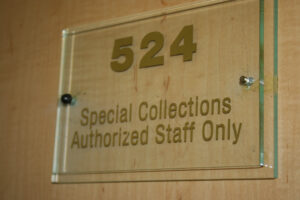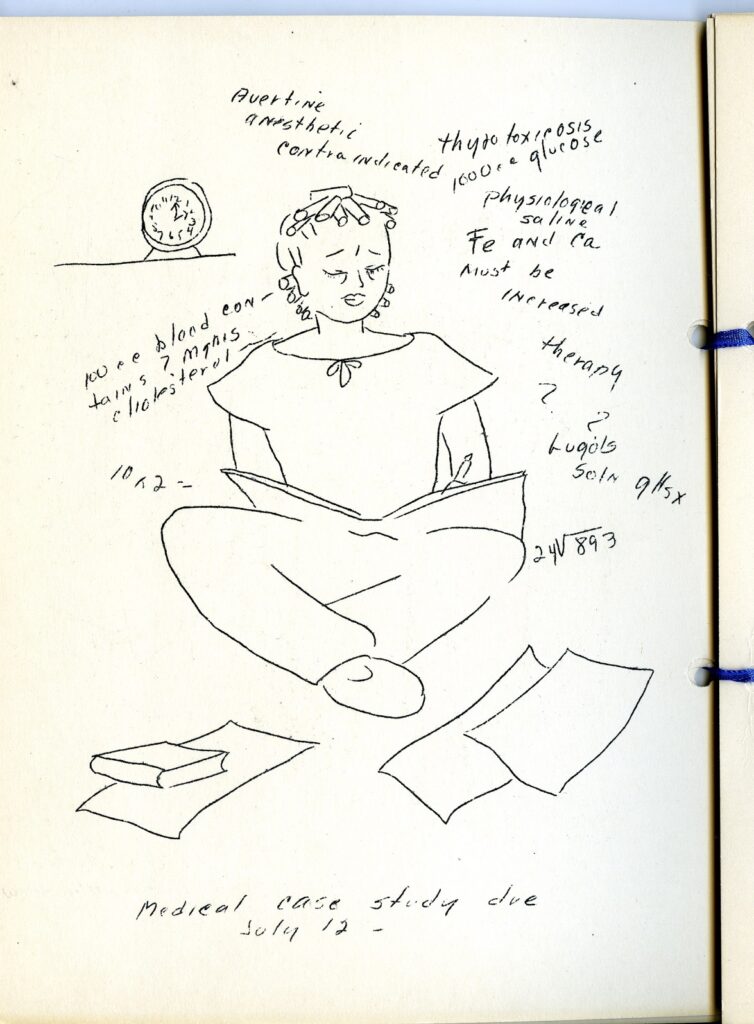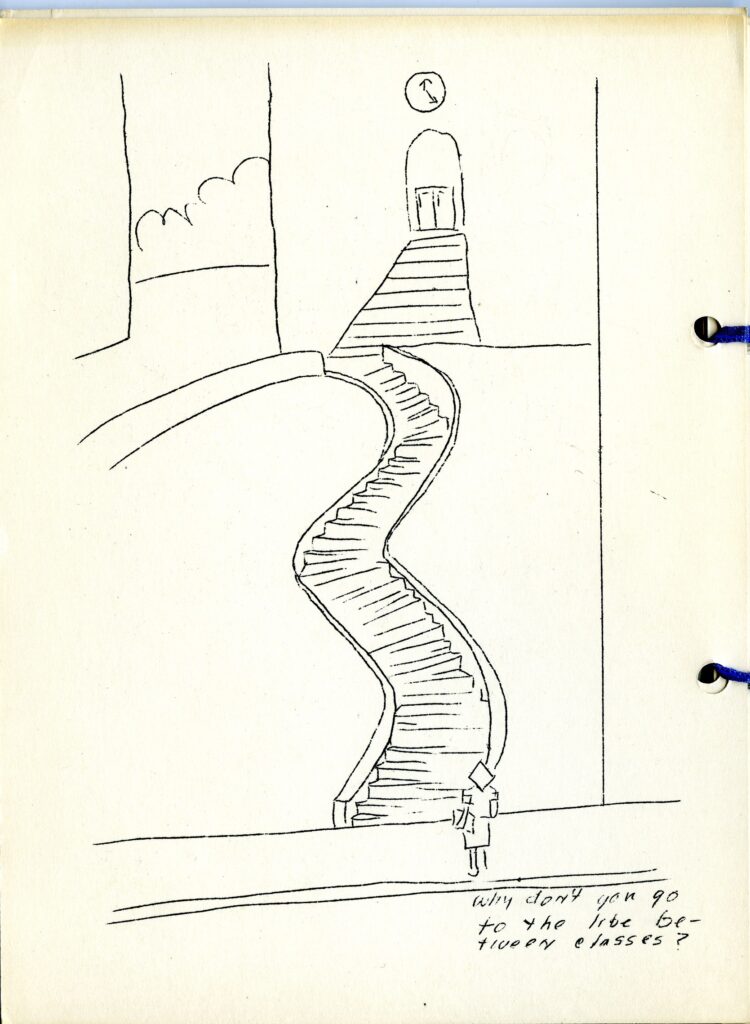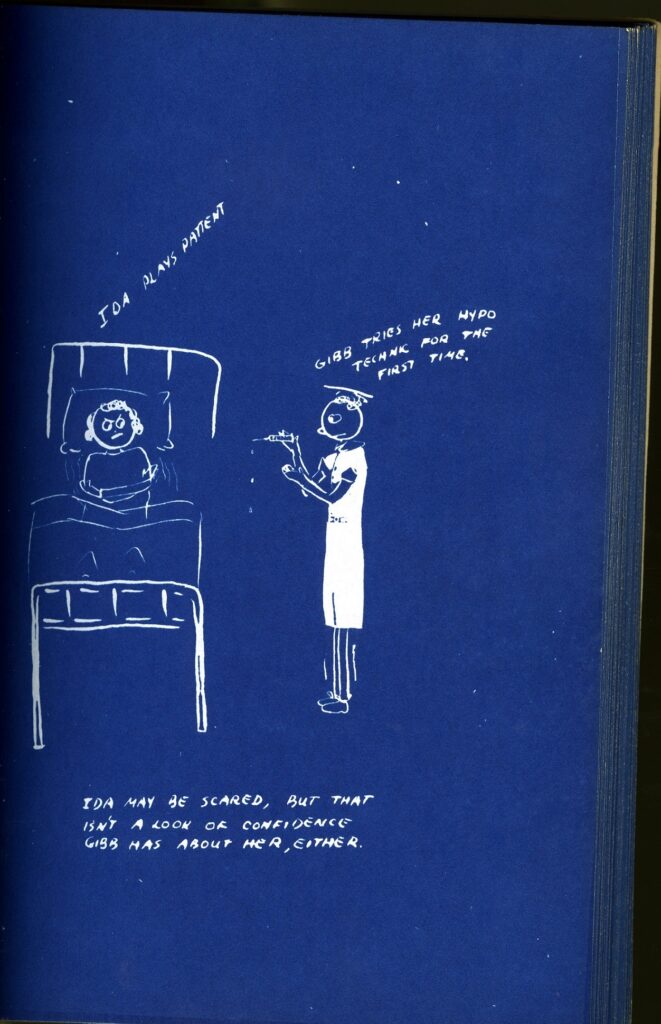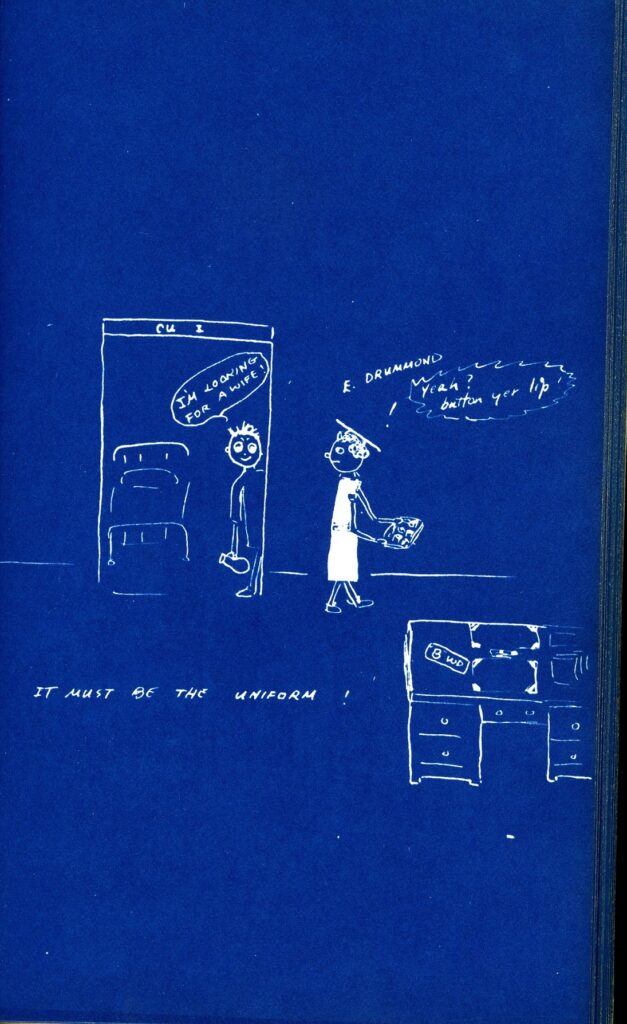UCSF Archives recently showcased historical material at UCSF Alumni Weekend. We had a great time sharing yearbooks and artifacts from the collections and hearing wonderful stories of UCSF history from attendees.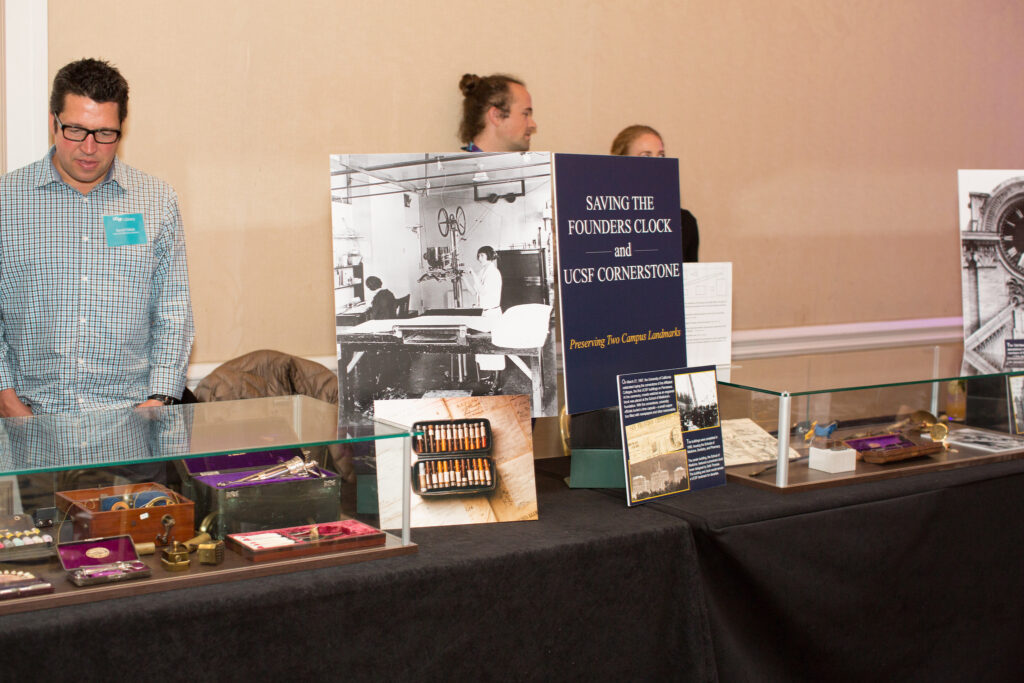
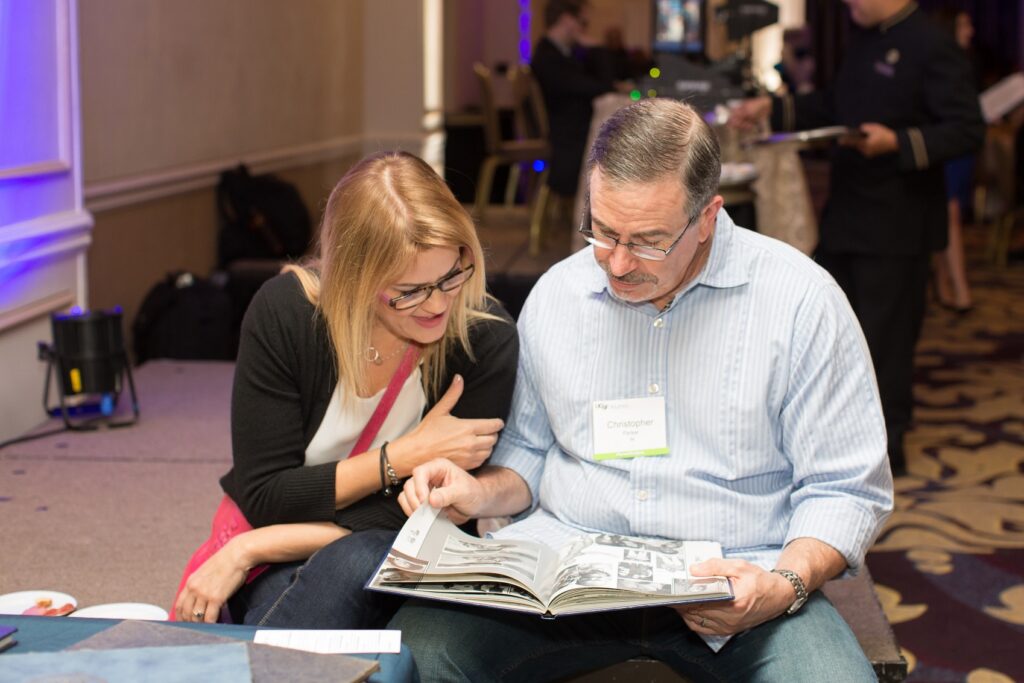 Selections from material that we shared at the event (and more!) are now on display on the 5th floor of the UCSF Library, 530 Parnassus Ave. The exhibit is free and open to the public during library hours. Come check out unique and beautiful health sciences artifacts and discover how UCSF community members saved the clock and cornerstone of the original 19th-century School of Medicine building from demolition.
Selections from material that we shared at the event (and more!) are now on display on the 5th floor of the UCSF Library, 530 Parnassus Ave. The exhibit is free and open to the public during library hours. Come check out unique and beautiful health sciences artifacts and discover how UCSF community members saved the clock and cornerstone of the original 19th-century School of Medicine building from demolition.
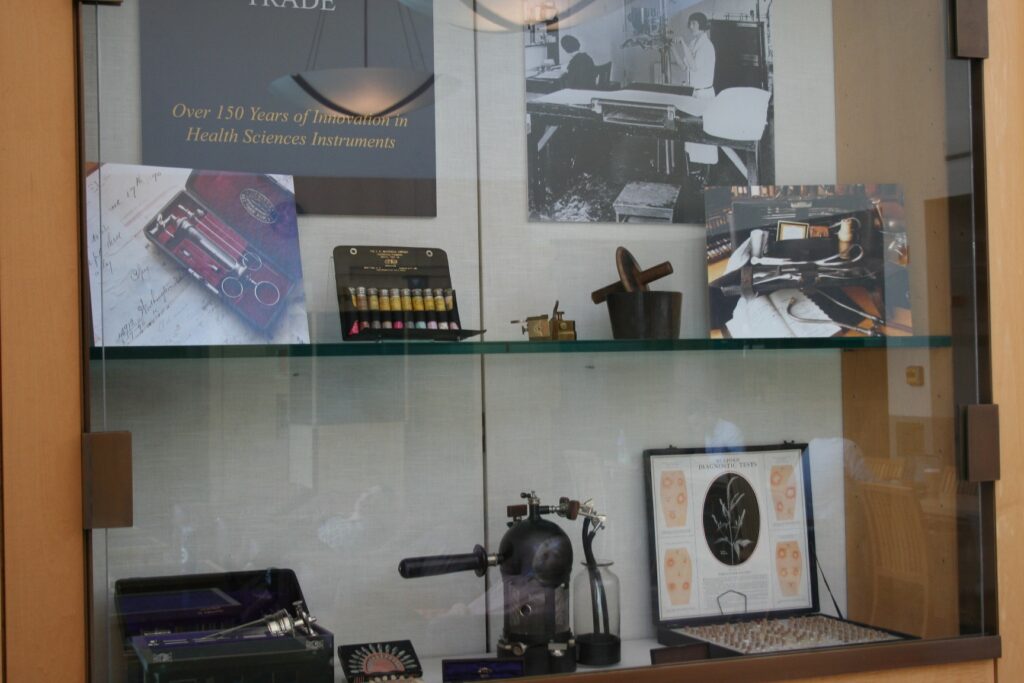
Tag Archives: ophthalmology
Medical Quackery Series: Bloodletting
In this series, we’ll be exploring artifacts and other material from our collections related to medical misinformation and fraud. Step right up folks and learn how everything from bleedings to electricity can cure your ills!
Bloodletting as a medical practice has existed for thousands of years; ancient peoples, including the Greeks and Egyptians, used bloodletting to cure numerous conditions. The treatment, which involved draining blood with leeches or by puncturing the skin with a sharp instrument, was based on the theory of bodily humors. People believed that good health resulted from a balance of the four humors: blood, phlegm, yellow bile, and black bile. A person suffered illness when these humors became unbalanced. Bloodletting was devised as a way to correct harmful imbalances in the body.
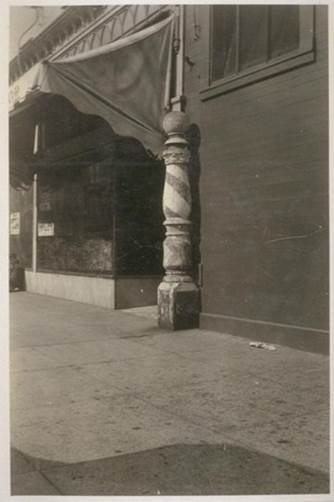
“Old wooden barber pole. 1900.” From the Graves (Roy D.) Pictorial Collection, ca. 1850-1968. Courtesy of the Bancroft Library, University of California, Berkeley, accessed via Calisphere: https://calisphere.org/item/ark:/13030/tf1r29n9jj
In Europe and the United States, surgeons and barbers offered bloodletting as a treatment for just about everything, from pneumonia to gout to cancer. Barbers so regularly performed bloodletting that they adopted a symbol to help advertise the service: the barber’s pole, a red and white striped pillar reminiscent of blood and bandages.
Leeches and a number of different instruments were used for bloodletting in the 18th and 19th centuries. The lancet was one of the simplest tools; it consisted of a sharp, pointed blade attached to a straight handle. A variation of this was the fleam, a wide double-edged blade at a right angle to the handle. The folding fleam pictured here includes two blades encased in a brass shield.

Folding fleam. Artifact Collection, number 431.
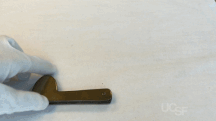
Folding fleam. Artifact Collection, number 431.
A spring lancet was more mechanized. It included a spring trigger that snapped the blade into a vein. Spring lancets were, perhaps unsurprisingly, difficult to clean and often became rife with bacteria.

Spring lancet and case. Artifact Collection, number 416.

Detail of spring lancet. Artifact Collection, number 416.
Scarificators allowed for multiple cuts to be made at once. The octagonal or round base housed six to twenty blades that released from the bottom with the flick of a lever.
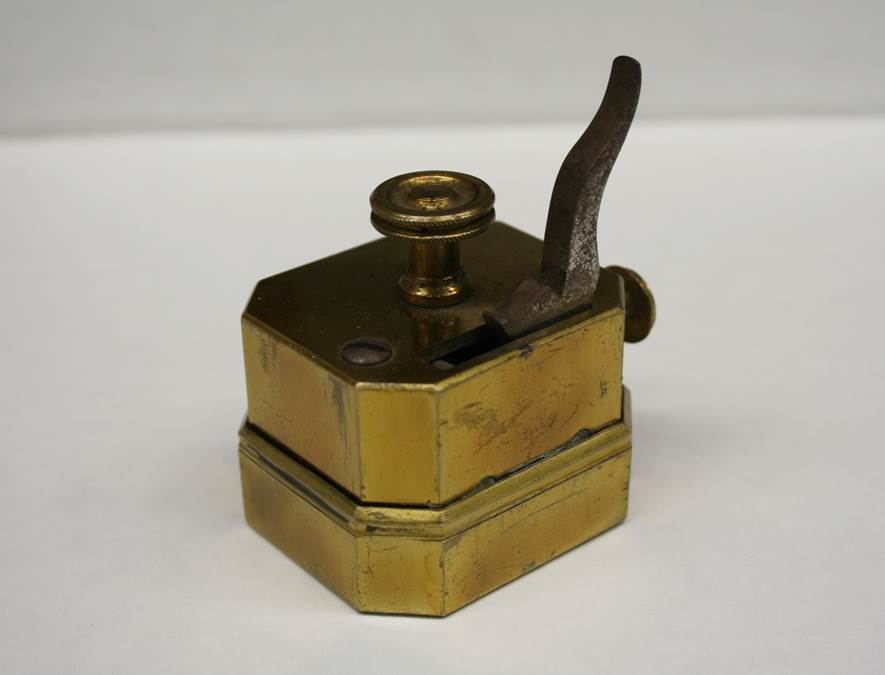
Scarificator. Artifact Collection, number 518.

Removing scarificator from original box. Artifact Collection, number 518.

Detail of scarificator with blades extended. Artifact Collection, number 518.

Blades of scarificator. Artifact Collection, number 518.
Bleeding bowls were often used to catch blood during the procedure. These came in different sizes and material, including brass, ceramic, and pewter.

Bleeding bowl. Artifact Collection, number 557.
Today, bloodletting is widely discredited as a medical treatment. However, phlebotomy therapy is used to treat certain conditions, including hemochromatosis, a genetic disorder that causes abnormal iron accumulation. Leeches are making a comeback too; some reconstructive surgeons use them to restore circulation following procedures.
To view more bloodletting instruments, make an appointment with the UCSF Archives. You can also check out our exhibit on the third floor of the UCSF Library until April 2016. You’ll see a 19th-century spring lancet engraved to UC Medical College Dean Richard Beverly Cole from his mother!
Lecture now online – History, Science, and Art of Ocular Prosthetics
The lecture History, Science, and Art of Ocular Prosthetics given by Robert S. Sherins, MD, in the UCSF Library on May 28th is now available free online.
This lecture, and the current exhibition on the fifth floor of the library, feature the Danz ocular pathology collection. The beautiful collection of glass eyes was exhibited several times during the past 50 years, however many historic details about this donation were lost. This unique artifact is used to tell the story of family traditions continued through the centuries on two continents. Through partnership with several members of the Danz family – ocularists: Phillip Danz of Sacramento; William Danz of San Francisco; and William Randy Danz of Ridgewood, New Jersey; as well as the author/lecturer, Dr. Robert Sherins, ophthalmologist, UCSF School of Medicine Alumnus Class of 1963; and UCSF archivist, Polina Ilieva, this exhibit demonstrates the evolution of skillful craftsmanship of Müller-Uri and Danz families, as well as the science and art of ocular prosthetics.
Please use this link to view Dr. Sherin’s presentation in full. More information about the story of the Danz collection can be found here.
About the UCSF Archives & Special Collections Lecture Series
UCSF Archives & Special Collections launched this lecture series to introduce a wider community to treasures and collections from its holdings, to provide an opportunity for researchers to discuss how they use this material, and to celebrate clinicians, scientists, and health care professionals who donated their papers to the archives.
New Exhibit: Many Faces, One UCSF
Visit the 3rd floor of the UCSF Library and view our new exhibit, Many Faces, One UCSF: Celebrating 150 Years of Innovation, Education, and Care.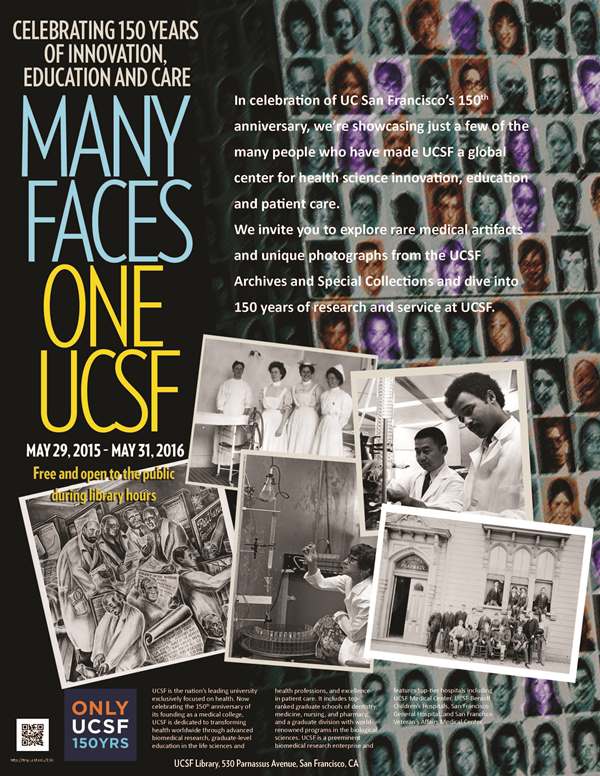
The exhibit is free and open to the public now through May 31, 2016. View rare medical artifacts and unique photographs from our collections and learn how UCSF has pioneered health science education, research, and patient care for over 150 years.
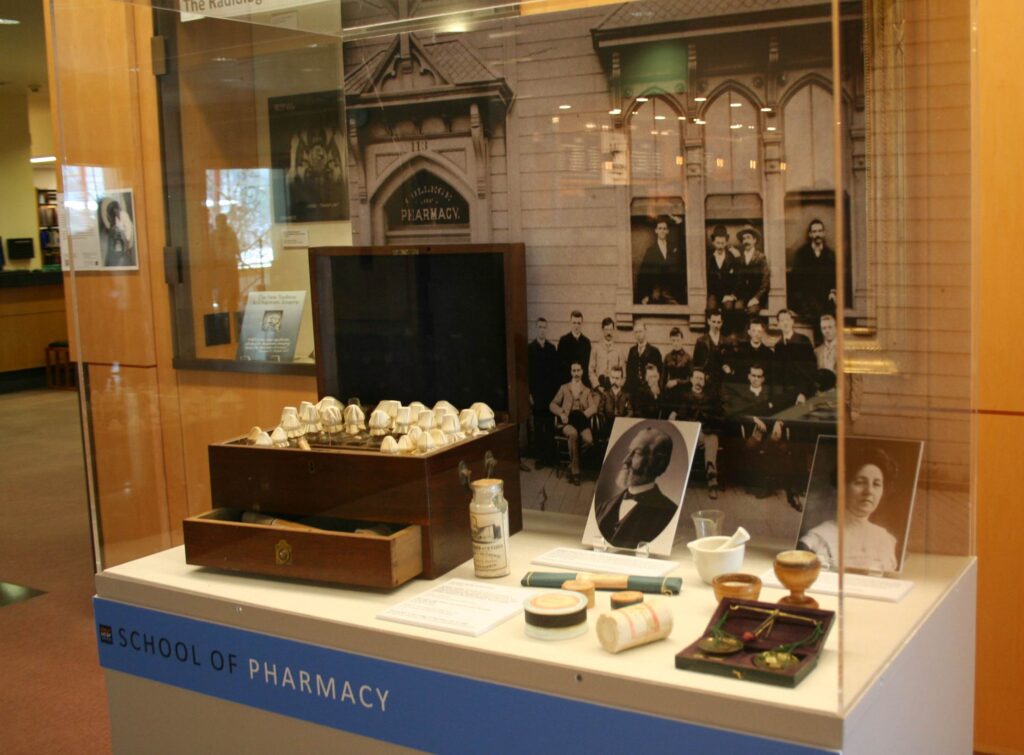
School of Pharmacy case. The exhibit includes cases dedicated to each of the four schools: School of Pharmacy, School of Nursing, School of Medicine, and School of Dentistry
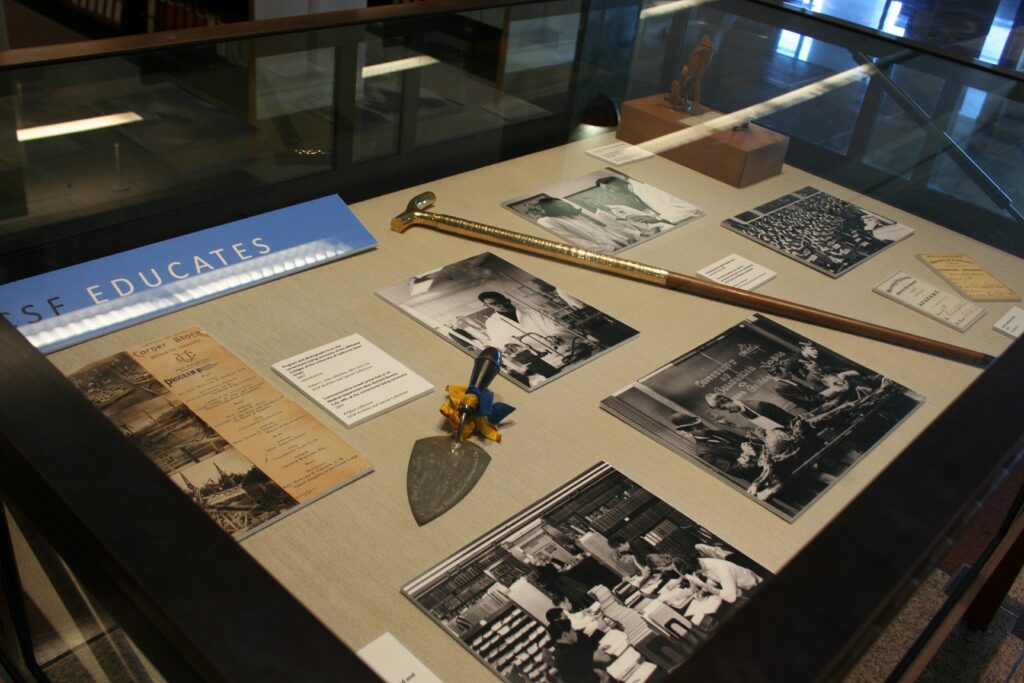
UCSF Educates case. The exhibit includes cases dedicated to the university’s missions of education, innovation, service, and care.
Visit the companion online exhibit here: Many Faces, One UCSF
We’re excited to share our collections with the public and proud to be a part of UCSF.
Through the Eyes of an Intern
Hi everyone, my name is Armani Fontanilla and I am an undergraduate student at the University of San Francisco interning at the UCSF Archives & Special Collections.
At the archives, I am currently tasked with the processing of small box collections, or the creation of box level inventories and the digitizing, and creation of, metadata for the archives that have yet to be placed into the virtual catalog. Other projects that I am potentially tasked with are research for the upcoming 150th Anniversary of UCSF on the level of researching stories, scanning images, and looking for documents, as well as helping with the vast inventory of the Medical Artifacts collection.

It’s restricted for a reason. We can’t reveal why. All you need to know is Maggie has the really cool “restricted” stamp. It’s actually really cool.

And wow is our inventory big… Get it? Because the texts are big?
Even though the potential projects are only potential projects, my senior co-workers, Maggie and Kelsi have both taught me a lot in the projects that I am currently working on. For example, Kelsi has taught me about her work with the Medical Artifacts collection: How the UCSF catalogs have changed from one form to another, and that cross-referencing catalogs with each new edition that has come through the library archives since 1864, one also has to decipher the writings and annotations of previous archivists, as well as come up with new ways to reorganize the collections in our possession.
Maggie, on the other hand, has taught me how to do the projects that I am currently doing, as opposed to the potential projects that Kelsi lets me shadow every so often. She has taught me proper labeling procedure, and storage techniques, as well as projects that mirror the one that Kelsi is currently doing, which would be creating catalogs for documents in storage.
Finally, the first project (that I am still working on when I’m not being taught by Maggie or Kelsi, is the creation of a digital inventory of UCSF affiliates and members. Fortunately, most of the physical inventory is in English, and it is all on-site. Unfortunately, the physical inventory itself is not backed up – folders that are not archival standard need to be replaced, labels need to be printed out because of the inconsistent handwriting of previous archivists (and this intern’s), and more files need to be created for the ever expanding role of UCSF affiliated persons who are recognized in the news worldwide – from China, to America, to Brazil, to the Philippines, UCSF’s impact on the world is growing. And my first, and current job, is to help sort the files so that we can keep track of them for people to use and peruse in the future.
Within these jumbled folders, however, lie treasures that I am so excited to find. While often the files just contain one or two articles, some contain as many as ten plus! And these articles are often varied – they come in the form of obituaries, photocopied documents, magazine clippings, newspaper articles, biographies, and more! But instead of letting me describe them, let me show you some examples.
A button with 1989 Nobel Prize Winners Michael Bishop and Harold Varmus.
Brown, Leatha. School of Nursing, Class of 1928.
Holt A. Cheng, 1904. He was the first Chinese to be licensed to practice medicine in California after graduating from the College of Physicians and Surgeons in San Francisco. After returning to China, he established the Guang Hua Medical Society, the first medical college of western medicine established by the Chinese, for the Chinese, and the first medical school to accept female applicants.
And finally, the UCSF archives are not only home to just Western schools of thought in medicine, but include Eastern Thought as well. On site and in a state-of-the art archival room, various Eastern texts in Chinese and Japanese are stored, either purchased by the Head Archivist, donated to UCSF, or willed by their owners.
Armani is currently a senior majoring in History with an emphasis on European and Asian Studies in the University of San Francisco (USF) public history program. After he graduates, he hopes to be able to earn a teaching position at his old high school, Bellarmine College Preparatory, and eventually pursue a Masters. In choosing the UCSF archives through the USF internship program, he hopes to not only practice skills that can only be found through working at an established institution but to also enhance his ability to do archival work and explore history of Western medicine at the archives.
Medicine Chest Video and UC Public Records
Watch the film to see Polina, Head of the UCSF Archives & Special Collections, show off a medicine chest we recently accessioned from the California Historical Society. Medicine chests were once things of beauty: hand-written labels, silver leaf coatings for pills, delicate bottles. The chest belonged to the family of Joseph Donoghue of San Francisco and was used during their travels to Hong Kong and Europe. We’ll bring you a longer post of the history of the chest soon.
[vimeo 109401114 w=500 h=281]
The chest includes 19th century pharmaceutical drugs from a pharmacy owned by a figure important in UCSF history– William Searby— that was located on Market Street. Searby was was a key player in the founding of the California College of Pharmacy (later UCSF School of Pharmacy). In addition to being the school’s first professor of Materia Medica, and later professor of pharmacy, he was also the second dean of the college. (We recently conserved a portrait of Searby from the 1880’s– read about that process here!)
The University of California Public Records project is on a quest to celebrate UC’s bevy of unique treasures. The University of California houses an incredible diversity of museums, libraries and other collections. Some are small and eclectic; others are recognized as world-class. Many are open to the public, and all are cared for by passionate curators, historians and scholars. Take a behind-the-scenes peek at UC’s incredible collections.
History Exhibit at UCSF’s 150th Anniversary Block Party 8
We had a great time at UCSF’s Block Party, held October 8th on the Mission Bay campus. The event celebrated the university’s growth over the past 150 years and featured live music, food, and entertainment.

The archives team in a Wells Fargo stagecoach at the Block Party. UCSF founder Hugh Toland reportedly used the company’s services in the mid-nineteenth century to transport pharmaceuticals to patients throughout California.
We organized an exhibit for the event that highlighted key moments and individuals from UCSF’s rich history. The displays featured artifacts and photos from the Archives and Special Collections, including Hugh Toland’s surgical instruments, a student nurse’s uniform, Guy Millberry’s dental equipment, and pharmacist William Searby’s brand-name medications.
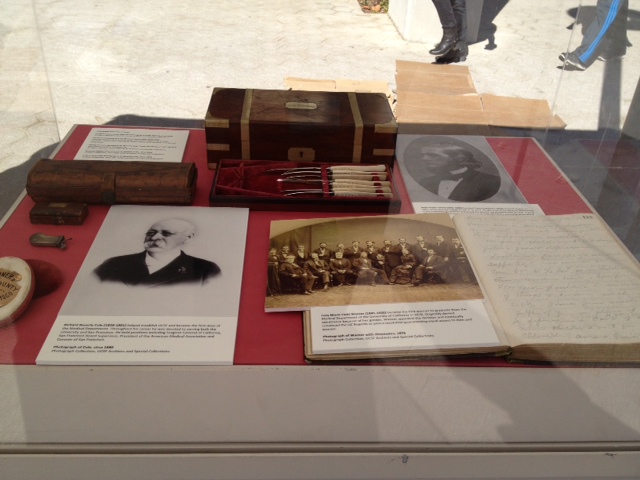
School of Medicine artifacts. UCSF founders Richard Cole and Hugh Toland are pictured along with Lucy Wanzer, UCSF’s first female graduate.
We also brought duplicate copies of UCSF’s student yearbooks and invited visitors to flip through them. One woman found a wild picture of her dentist from when he was a student in 1985!
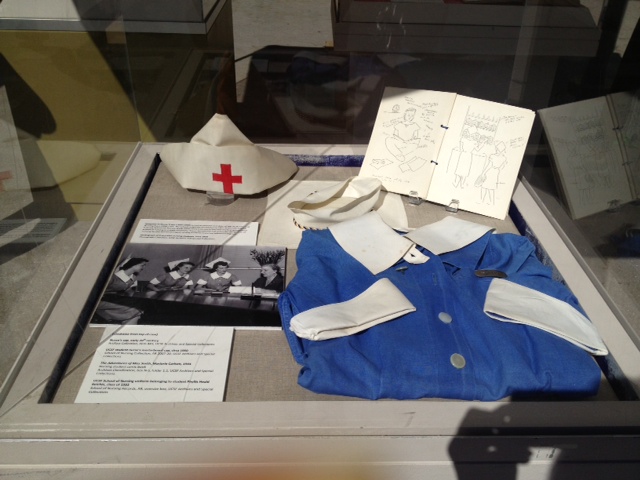
School of Nursing artifacts. Margaret Tracy and nursing students are pictured. Tracy served as director and dean of the UCSF School of Nursing from 1934-1956
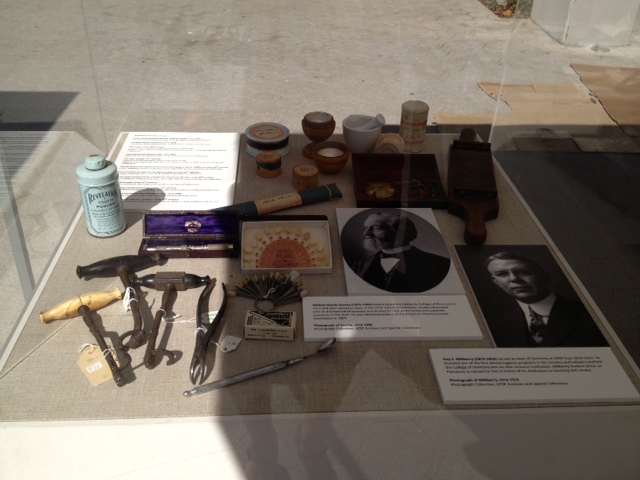
School of Pharmacy and School of Dentistry artifacts. William Searby and Guy Millberry are pictured. Searby helped found the California College of Pharmacy in 1872 and later served as dean of the School of Pharmacy. Millberry served as Dean of Dentistry from 1914-1939.
It was a lot of fun to share our collections. Thanks to everyone who stopped by the exhibit.
Exploring the Archives for 150: School of Nursing Comic Books
In preparation for UCSF’s 150th anniversary celebration exhibits, we’ve been doing a bit of exploring in the vaults. For the next several months, I’ll be posting some of the treasures we’ve discovered!
In 1944, the graduating class of the UCSF School of Nursing received a unique gift…a comic book dedicated to their experiences as student nurses.
This homemade book, created by Marjorie Carlson and titled The Adventures of Miss Smith, includes 31 illustrations that parody everything from late-night cram study sessions to overwhelming patient and doctor requests.
Carlson makes special note of the imposing landscape of Parnassus, a reference to which current students and staff can definitely relate!
In 1947, nursing student Phyllis P. Benson created a similar comic book, titled Nurses in Embryo.
In her introduction, Benson notes that the book “is the realization of an idea one of us had during our pre-clinical semester – to record some of the amusing, humiliating and exasperating experiences we’ve had in training both on and off duty. Each of our twenty-nine class members is represented…these things couldn’t have happened – but they did!”
While Benson maintains a humorous tone throughout, she also illustrates some serious issues that mid-century nursing students faced. For instance, five of the twenty-nine anecdotal illustrations reference sexual harassment from doctors and patients.
Documents like these provide excellent evidence for researchers looking to better understand students’ lives and experiences. They speak to the history of nursing training at UCSF and showcase unique individual stories. To view more images from the books, visit our digital collections or come see the real thing in the UCSF Archives and Special Collections.
Artificial Eyes in the Artifacts Collection
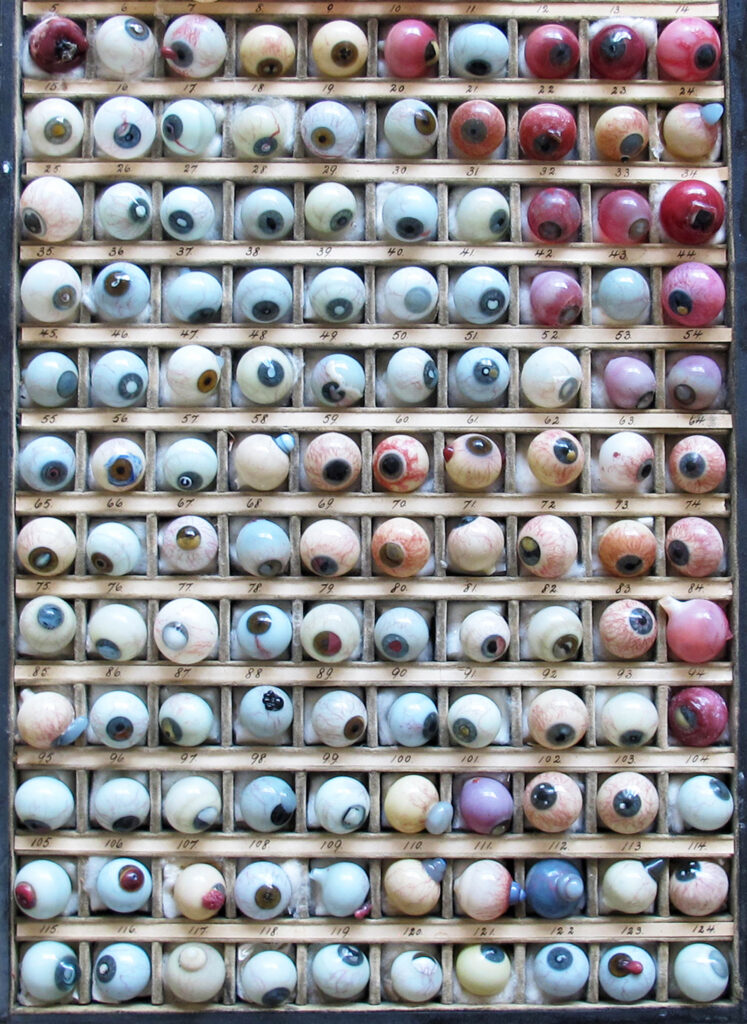
Danz Collection of Artificial Eyes Depicting Diseases and Defects
Pictured above, one of the many beautiful and unusual artifacts in our collections, the Danz Collection of Artificial Eyes Depicting Diseases and Defects. It was donated to UCSF by a local Ophthalmology firm, G. Danz & Sons, Ophthalmic Prosthetics, San Francisco, CA. The date of the collection is unknown, however our best estimates place it pre-1900.


